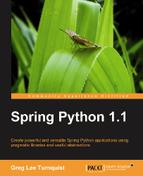Book Description
Create powerful and versatile Spring Python applications using pragmatic libraries and useful abstractions
Maximize the use of Spring features in Python and develop impressive Spring Python applications
Explore the versatility of Spring Python by integrating it with frameworks, libraries, and tools
Discover the non-intrusive Spring way of wiring together Python components
Packed with hands-on-examples, case studies, and clear explanations for better understanding
In Detail
Spring Python captures the concepts of the Spring Framework and Spring Security and brings them to the world of Python and provides many functional parts to assemble applications. Spring Python is all about using the many useful features of Spring to the fullest and making these features available when working with Python.
Get to grips with all of the concepts of Spring and apply these to the language and environment of Python to develop powerful applications for your own personal requirements. The book provides an introduction to Spring Python and steadily takes you towards the advanced features that this integration has to offer.
Spring uses the Java programming language. Spring Python, the first Spring extension to go live, allows developers to make maximum use of Spring features in Python. This book starts off by introducing each of the core building blocks of Spring Python using real code examples and high-level diagrams. It explores the various concepts of Spring Python with the help of examples and case studies and focuses on vital Spring Python features to make the lives of Python and Java developers simple. The early chapters cover simple applications with simple operations including data access, and then subsequent chapters scale up to multi-node, secured, transactional applications stopping short of very advanced level complexity.
This book will help you to scale your applications without having to add unnecessary complexity
Table of Contents
- Spring Python 1.1
- Table of Contents
- Spring Python 1.1
- Credits
- About the Author
- About the Reviewers
- Preface
- 1. Getting Started with Spring Python
- 2. The Heart of Spring Python—Inversion of Control
- 3. Adding Services to APIs
- 4. Easily Writing SQL Queries with Spring Python
- 5. Adding Integrity to your Data Access with Transactions
- Classic transaction issues
- Simplify by using @transactional
- Summary
- 6. Securing your Application with Spring Python
- Problems with coding security by hand
- Building web applications ignoring security
- Handling new security requirements
- Time to add security to our application
- Accessing security data from within the app
- Testing application security
- Configuring SQL-based security
- Configuring LDAP-based security
- Using multiple security providers is easy
- Coding our own security extension
- Some of the challenges with Spring Python Security
- Summary
- 7. Scaling your Application Across Nodes with Spring Python's Remoting
- 8. Case Study I—Integrating Spring Python with your Web Application
- 9. Creating Skeleton Apps with Coily
- 10. Case Study II—Integrating Spring Python with your Java Application
- Index
